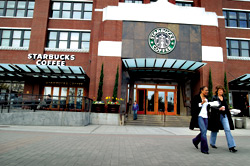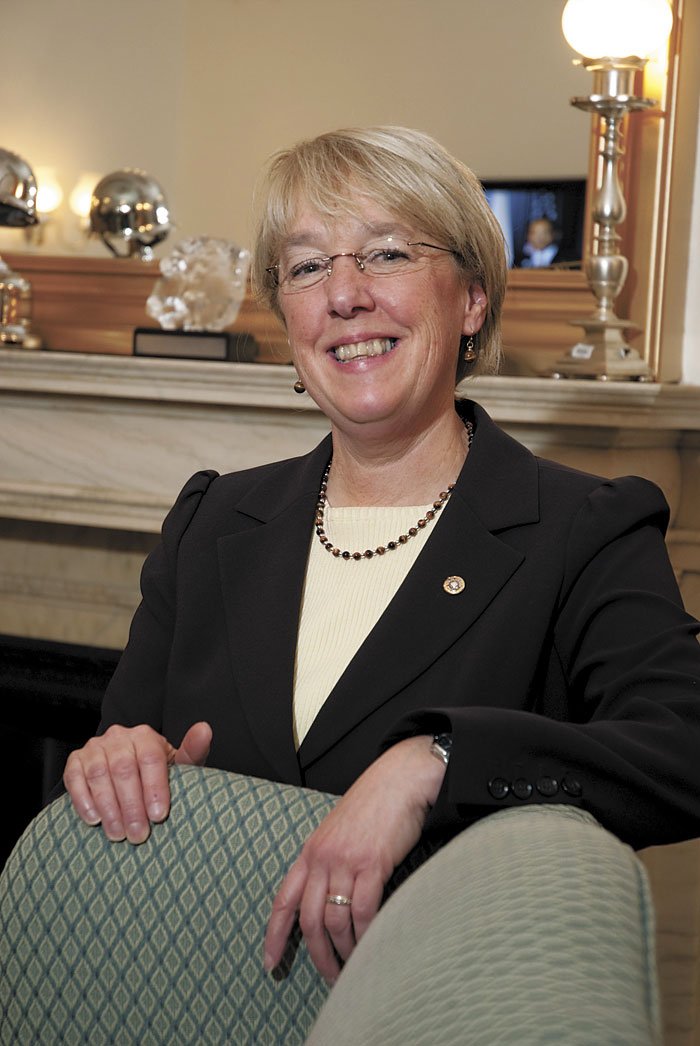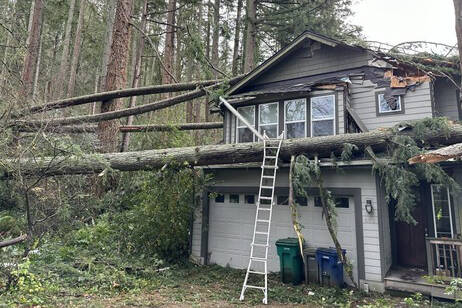Forget about leaked memos of corporate hand-wringing over the watering down of Seattle’s latte darling: Starbucks is growing like gangbusters—and a proposal at City Hall could mean a mammoth expansion of java-oriented office space in SoDo.
Developer Nitze-Stagen has filed a request calling for an amendment to the city’s comprehensive plan that would exempt a six-block area from current limits on office space. Bounded by South Walker Street, South Forest Street, Colorado Avenue South, and First Avenue South, this land is currently bordered by railroad tracks, wall to wall with warehouses and crisscrossed by forklifts. The only sign of office life is on the southern portion of the area in question: Starbucks’ corporate headquarters, which it leases from Nitze-Stagen. (Starbucks occupies about 75 percent of the 2-million-square-foot structure, according to Nitze-Stagen.) Other parcels that stand to be impacted currently include a Home Depot, a Sears Auto Center, the Outdoor Research Company Store, and a slew of low-slung buildings that house the likes of JC Marble & Granite, Washington Chain & Supply Inc., and Millwork Supply Co., among others. Nitze-Stagen owns some, but not all, of the land upon which these businesses reside.
Current law allows for office buildings in the six-block area, but density restrictions mean they must be in the neighborhood of 50,000 square feet. And rumor has it that Starbucks wants to go much bigger—more like 1 million square feet.
“I’ve heard that number, but I haven’t seen it confirmed in writing, and I don’t know if it would be one or two buildings,” says Tom Hauger, the city’s comprehensive planning manager.
Nitze-Stagen President Kevin Daniels says the 1-million-square-foot figure is just industry gossip. “I’ve been in meetings with Starbucks,” he says. “That number has never come up. I don’t know if it will be less than that or more than that. They’ve fully occupied what they can, and they’re a growing company, so at least this [proposal] gives them an opportunity to consider expanding in Seattle versus expanding throughout the world.”
For its part, Starbucks won’t comment beyond the realm of vaguely insinuative flack-speak. “I can’t comment on future needs for office space or future plans beyond what’s been disclosed already,” says spokesperson Brandon Borrman. Pressed for why Starbucks might need more office space, Borrman allows, “It’s been widely reported that Starbucks is going to grow the number of stores dramatically. Obviously, we have growth targets on the stores, and we’ll have the systems and processes in place needed to support them.”
Urban Visions principal Greg Smith, also a major land owner in the area, says he, too, has heard about Starbucks’ interest in building a million or more square feet of office space in SoDo. He notes that his company recently leased Starbucks 45,000 square feet in the Reedo Building near Qwest Field and that he and some others recently sold Starbucks a 200,000-square-foot building at 83 S. King St.
“I know they’re growing like crazy,” says Dave Gering, head of the Manufacturing Industrial Council of Greater Seattle. “I know it’s a great company. I think it would be wise to take a look at anything like this that they’d want to do.”
Gering says the real issue is density. “They’ve been a great neighbor,” he says. “But there are infrastructure issues. What’s hard right now down here is to see how we’d support a different land-use pattern. Forget how you feel about industry and what should stay, there are no amenities down here.”
Waiting for takeout last week at Mr. D’s, a Greek restaurant located near Starbucks headquarters on First Avenue South, journeyman technician Brian Dean ponders the prospect of hundreds—if not thousands—more of what he calls “cubicle dwellers” in the neighborhood.
“You’d have to have more than your KFC or Taco Bell up on Fourth Avenue for them to eat,” says Dean, who works for a nearby telecom company called Netversant Technologies Inc. “You’d have to have someplace for them to park.”
The Seattle City Council plans to consider just these sorts of issues over the next few months as part of an industrial lands study, due out in August. The study, overseen by the city’s Department of Planning and Development, will catalog Seattle’s industrial lands and discuss the role they play in the region’s economy and future. (There are public forums scheduled for April 10, April 24, and May 31.)
The DPD study is an update of one the city released in 2005. While the ’05 study didn’t produce any recommendations, it predicted that over the next 20 years, growth in industrial sectors could require approximately 260 to 360 additional acres of land. It also noted the pitfalls of development interest. “Allowing non-industrial uses in industrial zones can create speculation in the real estate market,” reads the report. “Some investors buy land anticipating that the zoning will change and a different use will be allowed. This conversion pressure can create negative impacts for industrial businesses.”
For his part, Nitze-Stagen President Daniels says his firm’s goal has always been to preserve the neighborhood’s industrial base. (The proposal stipulates that the expansion of office uses would only be for existing businesses and would involve no displacement of existing industrial uses.) “We’re on both sides, trying to protect the industrial base,” he says.” On the flip side, we want to give an opportunity for an employment center to expand if they wish.”
Millwork Supply Co. inhabits one of the few buildings Nitze-Stagen doesn’t own in the proposed rezone. The company manufactures wood moldings, windows, and doors, and has been doing business on First Avenue South since 1924. President and General Manager John Cochrane says having 1 million or more square feet of office space next door would be a “really big issue.”
“I think the neighborhood already has a serious parking problem,” he says. “It’s mostly because of the industrial buildings that have been turned into offices. Nitze-Stagen themselves are probably the biggest part of that parking problem.”
According to Cochrane, Nitze-Stagen built a parking lot for Starbucks employees across the street, but it was more than 200 spaces short of what they needed. “So these people are vying for parking out front, moving their cars hourly to dodge the meter maid,” he says. “It makes it tough for our retail customers, but is even harder for things like loading and unloading.”
Still, Cochrane says they’re going to have to find a way to coexist. And if Nitze-Stagen comes calling, he’s not interested in selling.
Henry Liebman, a local developer with significant holdings in SoDo, says that if the city changes the rules for Nitze-Stagen, they’re going to have to do it for everybody. And while he doubts the industrial lands study will result in much more than a recommendation to keep the status quo, he says a Starbucks push would most likely prevail because the company has clout. “They’ll get their zoning,” he speculates.
Down at City Hall, council member Sally Clark says it’s too early to tell how the specter of Starbucks expanding might inform the industrial lands debate. “It’s just one element of what I hear from the industrial folks is a constant nibbling around the edges,” says Clark. “They’re the cookie everybody wants to take a bite of. On a case-by-case basis, we need to say which one of these makes sense, which is the best bite to take.”
Clark, who chairs the Economic Development and Neighborhoods Committee, says the city certainly wants to keep Starbucks here. “And it’s certainly true that it’s difficult to find that much space,” she says. “Those are the kinds of demands that force people to look elsewhere.”
Council member Peter Steinbrueck, who chairs the Urban Development and Planning Committee, says he can’t comment on Starbucks specifically but notes: “We want to support thriving businesses. That goes without saying. But it has to be balanced with other needs and goals of the city.”
Steinbrueck considers industrial lands to be an “endangered species” in Seattle, and hopes the study will help the council make what are sure to be some tough decisions. “As the saying goes, ‘If you don’t know where you’re going, any road will do,'” he says. “We need to get a better handle on the future and the forces bearing down on us.”






